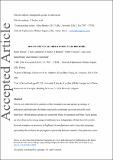Mixed-species aggregations in arthropods
Abstract
This review offers the first synthesis of the research on mixed-species groupings of arthropods and highlights the behavioural and evolutionary questions raised by such behaviour. Mixed-species groups are commonly found in mammals and birds. Such groups are also observed in a large range of arthropod taxa independent of their level of sociality. Several examples are presented to highlight the mechanisms underlying such groupings, particularly the evidence for phylogenetic proximity between members that promotes cross-species recognition. The advantages offered by such aggregates are described and discussed. These advantages can be attributed to the increase in group size and could be identical to those of non-mixed groupings, but competition-cooperation dynamics might also be involved, and such effects may differ between homo- and heterospecific groups. We discuss three extreme cases of interspecific recognition that are likely involved in mixed-species groups as vectors for cross-species aggregation: tolerance behaviour between two social species, one-way mechanism in which one species is attractive to others and two-way mechanism of mutual attraction. As shown in this review, the study of mixed-species groups offers biologists an interesting way to explore the frontiers of cooperation-competition, including the process of sympatric speciation.
Citation
Boulay , J , Aubernon , C , Ruxton , G D , Hédouin , V , Deneubourg , J-L & Charabidzé , D 2019 , ' Mixed-species aggregations in arthropods ' , Insect Science , vol. 26 , no. 1 , pp. 2-19 . https://doi.org/10.1111/1744-7917.12502
Publication
Insect Science
Status
Peer reviewed
ISSN
1744-7917Type
Journal item
Collections
Items in the St Andrews Research Repository are protected by copyright, with all rights reserved, unless otherwise indicated.

